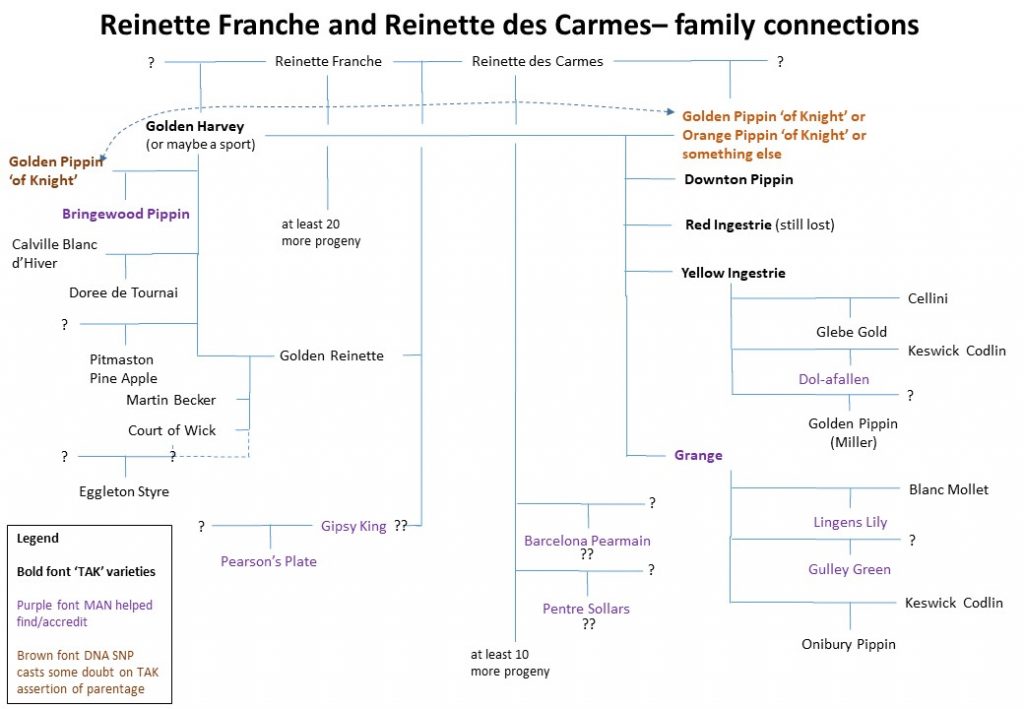“Lost” varieties re-discovered
MAN was founded in 1993 largely as a reaction to the decline of traditional orchards and consequent loss of varieties, our main objective was to re-discover and keep in cultivation old varieties of top fruit- particularly those associated with Wales and the Welsh Marches. At our first presentation at the Malvern Autumn Fruit Show in 1995, we mounted a display of unknown apple varieties seeking help in their identification from visitors. This evoked lots of interest but only one name. We also displayed a poster of “WANTED” apples.
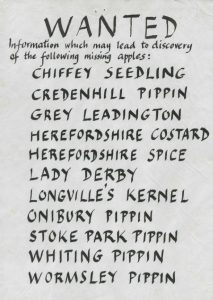
Since 1993 many varieties of old dessert and cooking apples have been re-found. Most are listed in ‘Orchard Gleanings’ in Apples and Pears (2014) though a few have been authenticated since, notably Bringewood Pippin, Round Winter Nonesuch, and Spring Grove Codlin. We show examples of the fruit for comparison with details from reference works (see Accreditation).
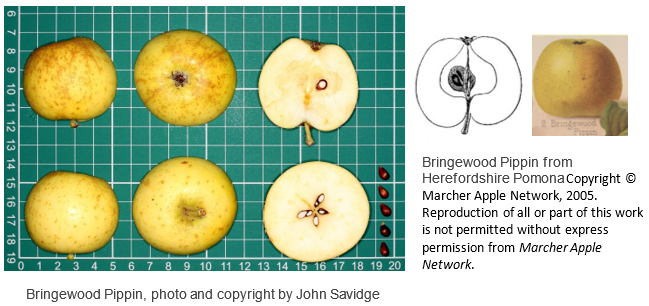
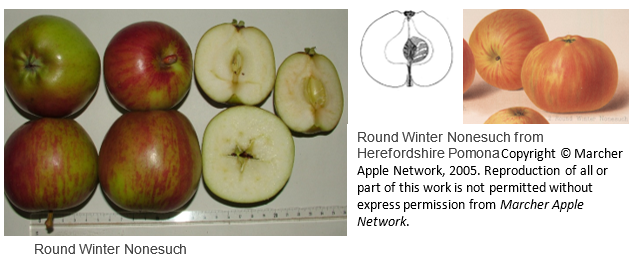
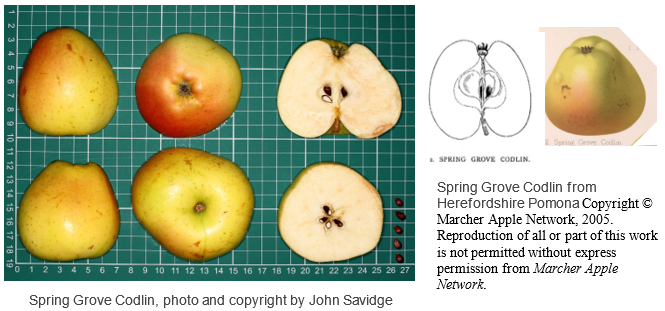
There are three chief ways ‘lost’ varieties have been re-found
- –Local campaigns have been launched by enthusiasts to find a particular apple once grown in their district. In this way Brithmawr was found in Glamorgan by Muriel Beck and friends, and Chatley Kernel in Worcestershire by Peter Weekes. These finds, and the dramatic rescue of Newland Sack by John Aldridge are documented in early MAN newsletters.
- – More often ‘lost’ varieties have surfaced by visitors bringing in unknown apples for identification at Apple Day events. It was an exciting moment at Church Stretton Apple Fair in 2004 when Tom Adams took out of his rucksack 3 small specimens of Gipsy King. By the time we had checked them with Hogg’s description the queue of visitors clutching bags of unknown apples snaked through the hall, and to avoid further disruption the show organiser dispatched us to a quiet room in another part of the building. The debut of Barcelona Pearmain, brought to Malvern Show by Mary Troughton in 2007, was another ‘red letter’ event, her old tree was still bearing prolifically.
- –The third way of discovering old varieties is by arranging visits to traditional orchards. Pig Aderyn and Pren Glas were found on a visit to an old estate in St. Dogmaels; Pig yr Wydd and Marged Nicolas came to light as a result of a survey of farm orchards around Llansadwrn commissioned by the Countryside Council for Wales. When we looked around the farm orchard in Shropshire which was home to Gipsy King two other old varieties were refound: the Bringewood Pippin and Round Winter Nonesuch. Such lucky breaks more than compensate for the hours spent trying to trace elusive apples like Ten Commandments. In many cases we have arrived just in time as the ancient decrepit trees, with hollow trunks ravaged by beetles and woodpeckers, might not have survived the next great storm.
Spring Grove Codlin and Bringewood Pippin
Identification can be a lengthy process and involve taking scions from an old tree and grafting young ones that can be grown on and studied in one of our museum orchards. It took over 10 years to determine that the large conical yellow green apple with its gentle red flush was indeed Spring Grove Codlin. We had strong suspicions because the source tree was found as a very old tree growing in the grounds of Elton Hall, the first home of Thomas Andrew knight after his marriage.
Confirmation that they are indeed lost varieties means that whatever name they may have been known by is not correct. Usually they also have no matching DNA entry in any database; there are exceptions, for instance when we found that the variety held at the National Fruit Collection as Bringewood Pippin was actually Sweeney Nonpareil!
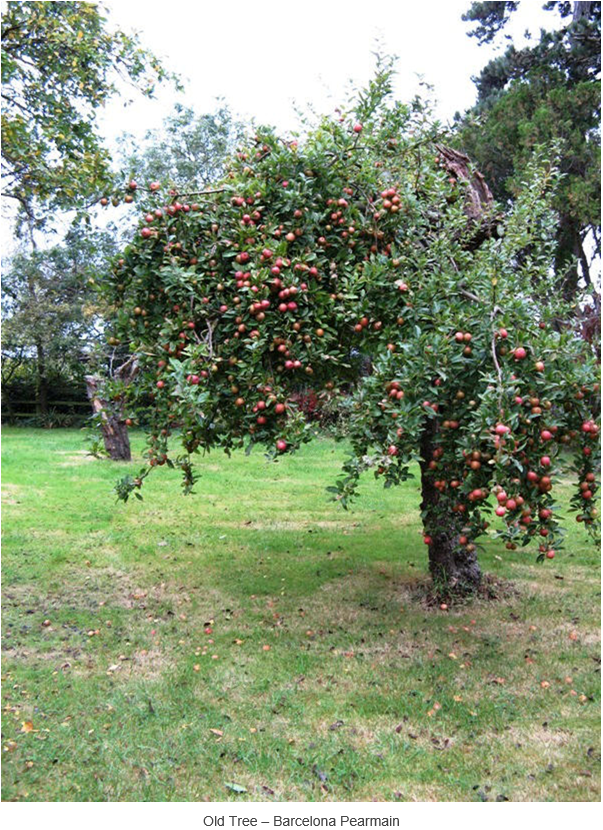
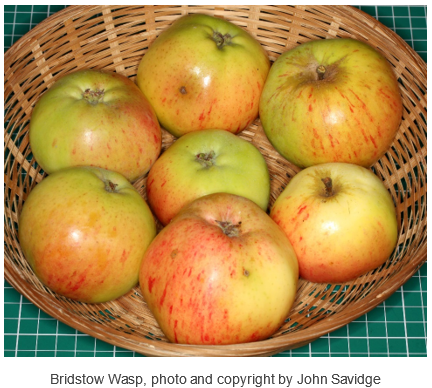
Bridstow Wasp
A variety known locally as Carnation around Hay-on-Wye was recognized as a “dead-ringer” for Bridstow Wasp, named after the village near Ross-on-Wye. It is an excellent match to an unpublished illustration in the Cider Museum, Hereford. Intriguingly, Hogg has miss-spelt it as Birdstow Wasp, a rare slip the like of which you’re more likely to find on these pages. Even more intriguingly, the variety is well known, though of later provenance, in Ireland as Beauty of Ballintaylor; recently DNA has enabled another tree growing in Totnes, Devon to be confirmed.
And a few disappointments
Sometimes, we have had a “disappointment” when the variety we have found and identified has turned out to be a synonym of a variety whose name has an older provenance and thus takes precedence. We had that experience with Credenhill Pippin, it’s Barnack Beauty from near Stamford and several more are listed below:

While we have many successes, there is still plenty of scope for further discoveries. It has been estimated that more than 300 varieties of dessert or culinary apples have been raised or found in Wales and the Welsh Marches. One hundred years ago local nurseries stocked a wide range of fruit, e.g., the 1907 catalogue of King’s Acre Nurseries (Hereford) lists 180 apple varieties for sale; in 1908 the catalogue of Fair Oak Nurseries at Bassaleg listed 100 varieties but added in a footnote that they had another 200 on trial which would be offered for sale in due course if they proved suitable.
During its early years, MAN assisted the National Fruit Collection add several varieties to their collection at Brogdale including: Chatley Kernel, Newland Sack, Onibury Pippin, Pig Aderyn, Sam’s Crab, Sugar-loaf Pippin, Ten Commandments.
Up till end 2022, 84 varieties have been accredited, the list is available here. And we’re working on another 40-50 more. Of the varieties accredited, MAN assisted with ‘re-finding’ another 36 lost varieties.
Among the varieties we’ve not yet provisionally identified, those with working names, some may still prove to be traditional varieties.
Thomas Andrew Knight – some varieties associated with his pioneer breeding work
MAN has had quite some success finding varieties associated with varieties bred by Thomas Andrew Knight about 200 years ago. These ‘finds’ were almost all in the vicinity of TAK homes in Herefordshire and south Shropshire. This is our local area and we feel a responsibility for resolving matters. We were pleased that the accreditation requests for a number of cultivars has been accepted, especially of Bringewood Pippin, Spring Grove Codlin, Grange, Gipsy King and several progeny. It has been most satisfying to note the consistency of these identifications based upon morphology with SSR evidence. A family tree for these is shown below for setting them in context.
One disappointment to MAN is that we consider Red Ingestrie has yet to be been found. Though both Bernwode and R V Rogers Nurseries market trees of that name and the NFC holds it as unknown, the SSR A1206 (etc.) is not consistent with them being a (half-)sibling to Yellow Ingestrie, instead, it is a match to Danish and Swedish accessions and likely a full sibling of Golden Reinette. For clarity we shall call it by the Danish name, even though it may have been raised in the UK. Nick Howard in a personal communication advised that SNP shows unambiguously Golden Harvey is a parent of Yellow Ingestrie and Downton Pippin; hence TAK’s assertion about parentage is in part wrong. Only one or other of Golden and Orange Pippins can be the other. We believe there is strong evidence showing that the Orange Pippin used was an unrecognised sport of Golden Harvey and thus would have been the mother. Golden Harvey cannot contribute conventional SSR alleles to A1206 for the marker-pairs CH01h01 and CH02c11 as these each mismatch by at least 4 bp. Furthermore, in the investigation into identification using SSR pear marker-pairs, mismatching alleles are in CH01d09 of 15 bp, and CH02b10 of 8bp. For details see the report here.
